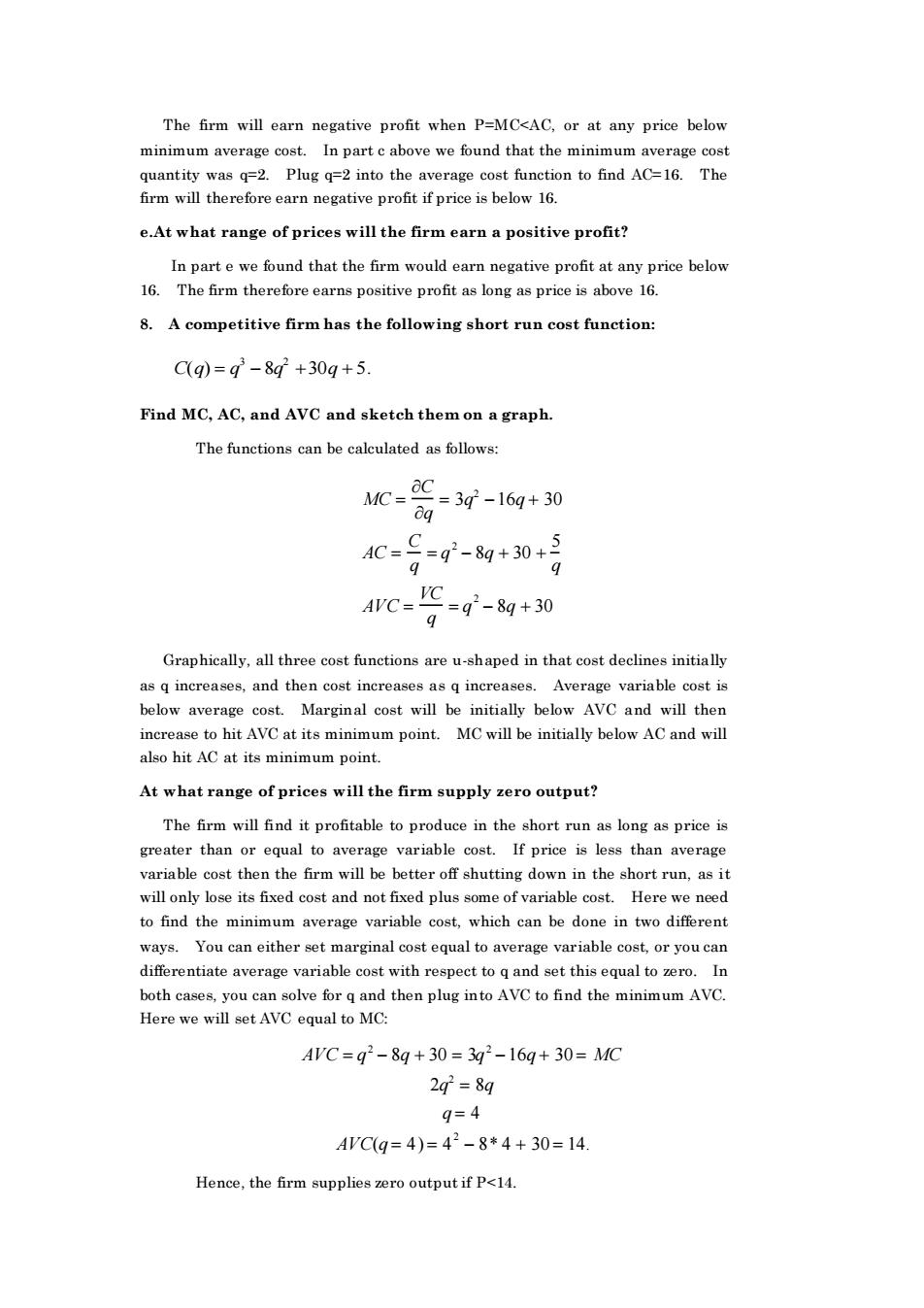正在加载图片...

The firm will earn negative profit when P=MC<AC,or at any price below minimum average cost.In partcabove we found that the minimum average cos quantity was q=2.Plug q=2 into the average cost function to find AC=16.The firm will therefore earn negative profit if price is below 16. e.At what range of prices will the firm earn a positive profit? In part e we found that the firm would earn negative profit at any price below 16.The firm therefore earns positive profit as long as price is above 16. 8.A competitive firm has the following short run cost function: C(q)=4-8g+30g+5. Find MC.AC,and AVC and sketch them on a graph The functions can be calculated as follows: MC=OC =3g2-16g+30 =g-89+30+ AC=C 4C==g-8g+30 q Graphically,all three cost functions are u-shaped in that cost declines initially as q increases,and then cost increases as q increases.Average variable cost is below average cost.Marginal cost will be initially below AVC and will then increase to hit AVC at its minimum point.MC will be initially below AC and will also hit AC at its minimum point. At what range of prices will the firm supply zero output? The firm will find it profitable to produce in the shortun as long as price is greater than or equal to average variable cost. If price is less than average variable cost then the firm will be better off shutting down in the short run,as it will only lose its fixed cost and not fixed plus some of variable cost.Here we need to find the minimum average variable cost,which can be done in two different arginal cost equal to avera variable cost,or youcan this equal to zero both ouead then pluginAVCtoind themnm AVC. Here we will set AVC equal to MC: 4AWC=g2-8g+30=3g2-16g+30=MC 2q=8q 94 AC(g=4)=42-8*4+30=14 Hence,the firm supplies zero output if P<14.The firm will earn negative profit when P=MC<AC, or at any price below minimum average cost. In part c above we found that the minimum average cost quantity was q=2. Plug q=2 into the average cost function to find AC=16. The firm will therefore earn negative profit if price is below 16. e.At what range of prices will the firm earn a positive profit? In part e we found that the firm would earn negative profit at any price below 16. The firm therefore earns positive profit as long as price is above 16. 8. A competitive firm has the following short run cost function: C(q) = q 3 − 8q 2 +30q + 5. Find MC, AC, and AVC and sketch them on a graph. The functions can be calculated as follows: MC = C q = 3q 2 −16q + 30 AC = C q = q 2 − 8q + 30 + 5 q AVC = VC q = q 2 − 8q + 30 Graphically, all three cost functions are u-shaped in that cost declines initially as q increases, and then cost increases as q increases. Average variable cost is below average cost. Marginal cost will be initially below AVC and will then increase to hit AVC at its minimum point. MC will be initially below AC and will also hit AC at its minimum point. At what range of prices will the firm supply zero output? The firm will find it profitable to produce in the short run as long as price is greater than or equal to average variable cost. If price is less than average variable cost then the firm will be better off shutting down in the short run, as it will only lose its fixed cost and not fixed plus some of variable cost. Here we need to find the minimum average variable cost, which can be done in two different ways. You can either set marginal cost equal to average variable cost, or you can differentiate average variable cost with respect to q and set this equal to zero. In both cases, you can solve for q and then plug into AVC to find the minimum AVC. Here we will set AVC equal to MC: AVC = q 2 − 8q + 30 = 3q 2 −16q + 30 = MC 2q 2 = 8q q = 4 AVC(q = 4) = 4 2 − 8* 4 + 30 = 14. Hence, the firm supplies zero output if P<14